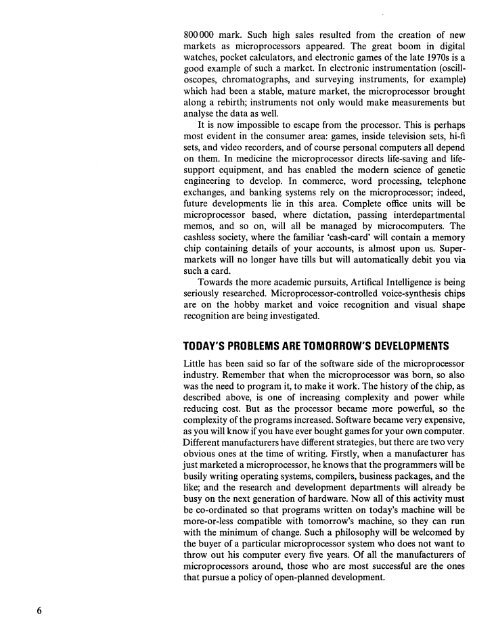Microcomputer Circuits and Processes
Microcomputer Circuits and Processes
Microcomputer Circuits and Processes
Create successful ePaper yourself
Turn your PDF publications into a flip-book with our unique Google optimized e-Paper software.
800000 mark. Such high sales resulted from the creation of new<br />
markets as microprocessors appeared. The great boom in digital<br />
watches, pocket calculators, <strong>and</strong> electronic games of the late 1970s is a<br />
good example of such a market. In electronic instrumentation (oscilloscopes,<br />
chromatographs, <strong>and</strong> surveying instruments, for example)<br />
which had been a stable, mature market, the microprocessor brought<br />
along a rebirth; instruments not only would make measurements but<br />
analyse the data as well.<br />
It is now impossible to escape from the processor. This is perhaps<br />
most evident in the consumer area: games, inside television sets, hi~fi<br />
sets, <strong>and</strong> video recorders, <strong>and</strong> of course personal computers all depend<br />
on them. In medicine the microprocessor directs life-saving <strong>and</strong> lifesupport<br />
equipment, <strong>and</strong> has enabled the modern science of genetic<br />
engineering to develop. In commerce, word processing, telephone<br />
exchanges, <strong>and</strong> banking systems rely on the microprocessor; indeed,<br />
future developments lie in this area. Complete office units will be<br />
microprocessor based, where dictation, passing interdepartmental<br />
memos, <strong>and</strong> so on, will all be managed by microcomputers. The<br />
cashless society, where the familiar 'cash..;card' will contain a memory<br />
chip containing details of your accounts, is almost upon us. Supermarkets<br />
will no longer have tills but will automatically debit you via<br />
such a card.<br />
Towards the more academic pursuits, Artifical Intelligence is being<br />
seriously researched. Microprocessor-controlled voice-synthesis chips<br />
are on the hobby market <strong>and</strong> voice recognition <strong>and</strong> visual shape<br />
recognition are being investigated.<br />
TODAY'S PROBLEMS ARE TOMORROW'S DEVELOPMENTS<br />
Little has been said so far of the software side of the microprocessor<br />
industry. Remember that when the microprocessor was born, so also<br />
was the need to program it, to make it work. The history of the chip, as<br />
described above, is one of increasing complexity <strong>and</strong> power while<br />
reducing cost. But as the processor became more powerful, so the<br />
complexity of the programs increased. Software became very expensive,<br />
as you will know if you have ever bought games for your own computer.<br />
Different manufacturers have different strategies, but there are two very<br />
obvious ones at the time of writing. Firstly, when a manufacturer has<br />
just marketed a microprocessor, he knows that the programmers will be<br />
busily writing operating systems, compilers, business packages, <strong>and</strong> the<br />
like; <strong>and</strong> the research <strong>and</strong> development departments will already be<br />
busy on the next generation of hardware. Now all of this activity must<br />
be co-ordinated so that programs written on today's machine will be<br />
more-or-Iess compatible with tomorrow's machine, so they can run<br />
with the minimum of change. Such a philosophy will be welcomed by<br />
the buyer of a particular microprocessor system who does not want to<br />
throw out his computer every five years. Of all the manufacturers of<br />
microprocessors around, those who are most successful are the ones<br />
that pursue a policy of open-planned development.<br />
6











